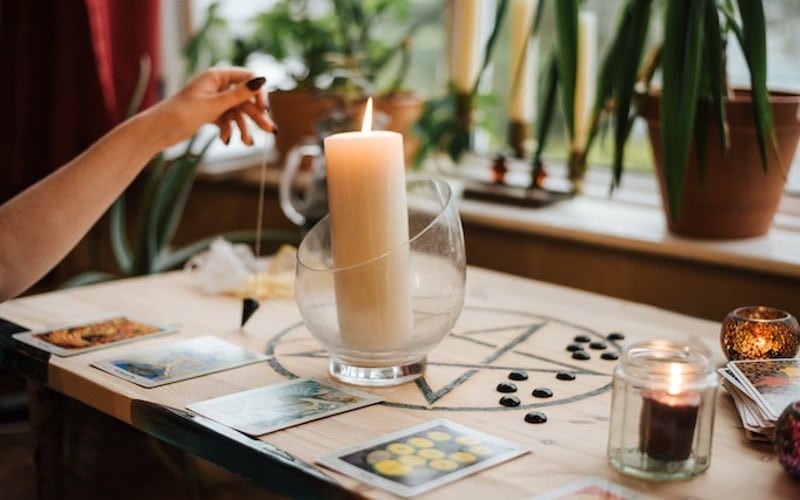The Death card is one of the scariest cards in Tarot. My clients get really anxious when it appears in a spread, anticipating an unfavorable outcome to their question.
But contrary to its ominous name, the Death card does not predict physical demise. Instead, it signifies transformation, endings, and new beginnings. It’s a pivotal card in the Major Arcana, marking a significant stage in the Fool’s journey toward enlightenment and self-discovery.
In the Tarot’s narrative, the Death card is the thirteenth step in the Fool’s journey through the Major Arcana. This position is significant, as thirteen, known as a bad luck number in pop culture, is a number associated with transformation and rebirth.
The Death card represents a crucial turning point, a moment of transition where the old must be released to make way for the new. It’s a symbol of the cyclical nature of life, reminding us that every ending is but a new beginning in disguise.
Death Tarot Card Keywords and General Associations
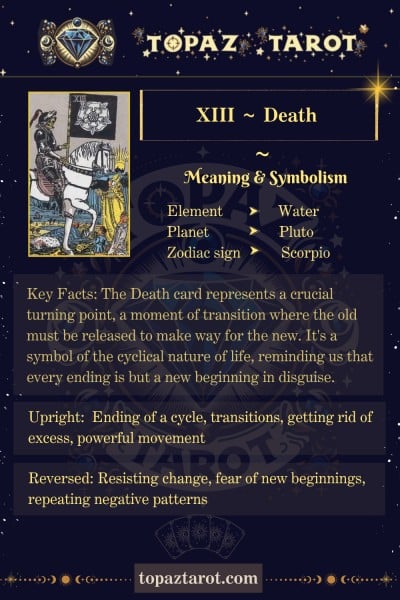
The Death card, numbered XIII in the Major Arcana, is steeped in a multitude of meanings and associations. Let’s not forget that death is only real to our egos! Our soul is limited. So this card is more associated with change and transition than actual death.
Its themes revolve around transformation, endings, rebirth, and the cyclical nature of life. When upright, it signifies the end of a cycle, transitions, and powerful movement. In its reversed position, it represents resistance to change, fear of new beginnings, and repeating negative patterns.
Key associations of the Death card include:
- Upright: Ending of a cycle, transitions, getting rid of excess, powerful movement
- Reversed: Resisting change, fear of new beginnings, repeating negative patterns
The Death card is associated with the zodiac sign of Scorpio, known for its intensity, depth, and capacity for transformation. This association further emphasizes the card’s themes of change, rebirth, and the exploration of life’s deeper mysteries.
The Death card also carries elemental and planetary associations. It is linked to the element of Water, symbolizing emotions, intuition, and the subconscious. Its planetary ruler is Pluto, the planet of transformation and regeneration.
Detailed Description of the Death Tarot Card
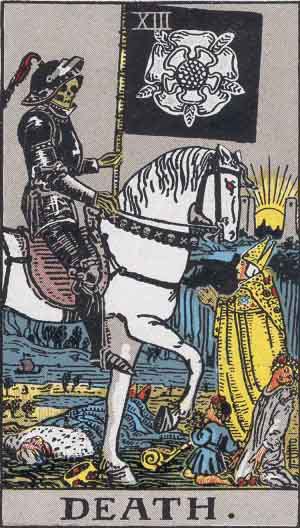
The Death card in the Rider-Waite-Colman tarot deck depicts a skeletal figure, the Grim Reaper, riding a white horse. Clad in armor, the figure holds a black flag adorned with a white, floral pattern and the Roman numerals XIII, signifying the card’s position in the Major Arcana. The armor symbolizes invincibility and dominance, underscoring the inevitability of change and transformation.
The card’s background features a diverse array of figures, including a king, a child, and a woman. These figures illustrate that death and transformation are universal experiences, transcending age, status, and gender. The king, who is typically associated with power and authority, lies defeated, reminding us that death is the great equalizer.
A boat sails towards the sun in the distance, symbolizing hope and the promise of new beginnings following the end of a cycle. The rising sun is a potent symbol of rebirth and renewal, reinforcing the card’s themes of transformation and change.
Meaning of the Death Tarot Card
If you got this card in your reading, don’t panic. Instead, take a deep breath and think about what aspects of your life need closure. This card represents the end of one phase and the beginning of another, symbolizing the cyclical nature of life and the inevitability of change. Death is necessary for us to evolve! The Death is a card of transformation, urging us to let go of the old to make way for the new.
The meaning of the Death card can vary depending on the context of the reading. For some of my clients it has meant the end of a relationship, for others a career change, and for others a deep and personal transformation. It encourages us to embrace change, to let go of what no longer serves us, and to embark on a new journey of growth and self-discovery.
In a broader context, the Death card can represent societal or cultural transformations. It can signify the end of an era or the dissolution of old paradigms, making way for new ideas and perspectives (for example, the advent of the digital age and the widespread adoption of the internet). It’s a card that speaks to the collective human experience, reflecting the ongoing evolution of our societies and cultures.
Interpretation of the Death Tarot Card
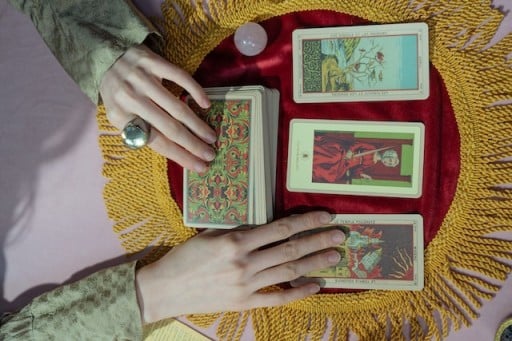
The Death card’s interpretation can differ significantly depending on whether it appears in its upright or reversed position. Its meanings can be applied to various areas of life, including love, career, personal growth, and spiritual development.
Upright Death Tarot Card
When the Death card appears upright in a reading, it signifies the end of a cycle and the onset of a new phase. It’s a card of transformation, urging us to let go of what no longer serves us and embrace change.
For example, one of my clients was going through a depression where nothing in his life seemed to make sense. Seeing Death in his Tarot reading helped him realize that he was just going through a phase and that he was preparing for a new chapter in his life.
In the context of love and relationships, the upright Death card can mean the end of a relationship or a significant change within a relationship. If you receive this card and are going through a rough patch in your love life, try to let go of what is no longer serving you and open your heart to new possibilities.
In terms of career and work, the Death card can indicate a significant change, such as a career shift, job change, or the end of a particular work phase. It encourages us to embrace these changes and see them as opportunities for growth and development.
Reversed Death Tarot Card
When the Death card appears upside down in a reading, it indicates resistance to change and fear of new beginnings. You are probably repeating negative patterns that keep you stuck in a problematic state. Another possibility I see in my readings is an unwillingness to let go of the past.
In the context of love and relationships, the reversed Death card can signify a reluctance to let go of a past relationship or a fear of moving on. What person are you still holding onto that won’t let you move on? Face these fears and embrace the possibility of new love.
What about career and work? Well, the reversed Death card can indicate a fear of career change or a reluctance to embrace new work opportunities. You can have a more fulfilling professional life by stepping out of your comfort zone! Give it a try.
In terms of personal challenges, the reversed Death card can indicate a fear of confronting deep-seated issues. But guess what? These uncomfortable issues hold the seeds of your personal evolution. Death encourages us to face these challenges head-on and embrace the transformative power of change.
Comparing and Contrasting The Death with The Lovers and The Tower
Some cards have similar meanings, but they don’t have exactly the same message. Let’s take a look at how the Death compares to other tarot cards to get additional insight into the card’s meanings and interpretations.
Compared with The Lovers
The Lovers card, like the Death card, deals with significant life choices and transitions. However, while the Death card signifies endings and new beginnings, The Lovers card is more about choices and commitments in love and relationships. Both cards speak to the transformative power of love, but they approach it from different angles.
Compared with The Tower
The Tower card, like the Death card, signifies sudden and unexpected change. However, while the Death card is about gradual transformation and the natural cycle of endings and beginnings, The Tower card represents sudden upheaval and disruption. Both cards remind us that change is an inevitable part of life, but they depict different types of change.
Death Tarot Card in Specific Readings
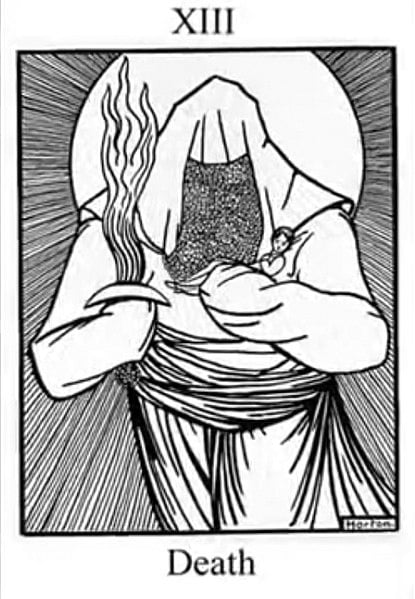
The interpretation of the Death card can vary significantly depending on the type of reading and the specific question being asked. It’s important to consider the context of the reading and the position of the card in the spread.
Yes-no readings
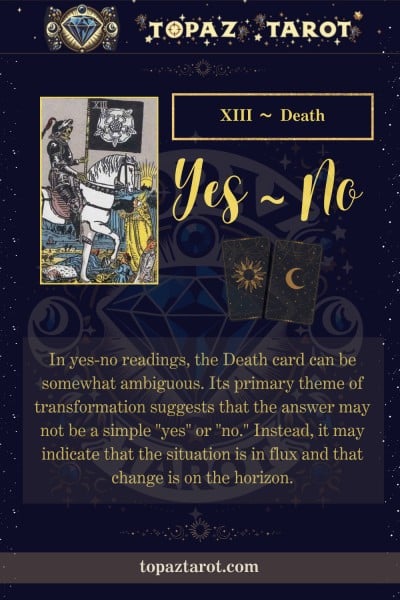
In yes-no readings, the Death card can be somewhat ambiguous. Its primary theme of transformation suggests that the answer may not be a simple “yes” or “no.” Instead, it may indicate that the situation is in flux and that change is on the horizon.
For example, if the question is whether your love affair will continue, the death card might suggest that the situation is coming to an end and that a new phase is about to begin. On the other hand, if the question is whether change is coming, the Death card would suggest a definite “yes.”
Love readings
In love readings, the Death card can indicate significant changes in one’s love life. This could mean the end of a relationship, a shift in the dynamics of a current relationship, or the beginning of a new one. Your personal circumstances and unique feelings will help you realize what exactly it is,
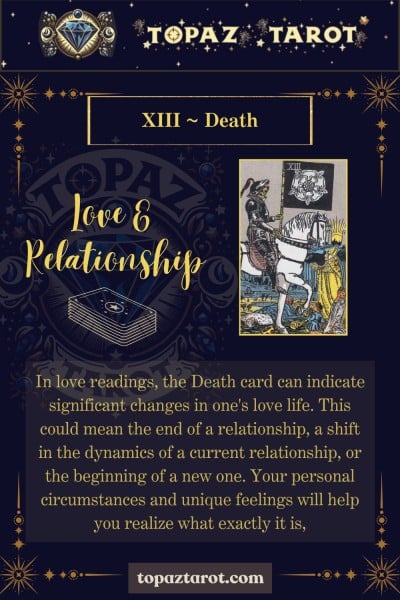
For example, if the question is about the future of a relationship, the Death card might suggest that the relationship is going through a period of transformation, which could lead to a deepening of the bond or the end of the relationship, depending on other cards in the spread and your context.
Work readings
In work readings, the Death card can indicate significant changes in one’s career or work situation. This could mean the end of a job, a career shift, or the beginning of a new work phase.
For example, if the question is about the future of your career, the Death card might suggest that a significant career change is on the horizon. This could mean a job change, a career shift, or even a complete career transformation!
Key Card Combinations
The Death card’s meanings and interpretations can be further nuanced when it appears in combination with the following cards in a spread.
Combined with The Empress

Whenever the Death card appears alongside The Empress within a spread, it carries the implication of a profound transformation deeply rooted in concepts of nurturing, creativity, or abundance. Symbolizing fertility and growth, The Empress signifies that the changes denoted by the Death card will ultimately give rise to an extended period marked by heightened productivity, boundless creativity, or emotional gratification.
For example, one of my clients asked about the future of her career through this combination during a reading. This indicated that she would be embarking on a new professional endeavor that would provide an outlet for artistic expression.
Alternatively interpreted through personal development readings; this pair could signify transformations that foster enhanced self-care practices and individual advancement.
Combined with The Hermit
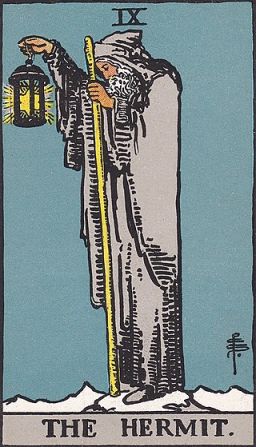
When the Death card appears alongside The Hermit in a spread it indicates the potential for a transformative experience that prompts introspection, solitude, or self-discovery. The presence of The Hermit archetype symbolizes the act of reflecting inwardly and pursuing wisdom.
Therefore the changes depicted by the Death card suggest that they will ultimately lead to a profound understanding of yourself and your journey in life.
For one of my clients, this combination meant a metamorphosis that led to a rich period of self-reflection and personal development. He had just come out of a long-term relationship, and this period of solitude allowed him to gain great insight into his inner self.
Frequently Asked Questions about the Death Tarot Card
No, the Death card rarely signifies physical death. It’s more about endings and new beginnings, transformation, and change.
Not necessarily. While it can signify endings and transitions, which can be challenging, it also represents new beginnings and transformation, which can be positive.
In a love reading, the Death card can signify the end of a relationship, a shift in the dynamics of a current relationship, or the beginning of a new relationship.
In a career reading, the Death card can signify the end of a job, a career shift, or the beginning of a new work phase.
Last thoughts on the Death Card
Our minds and egos are very afraid of what death represents. This limited side of our identity clings to what’s familiar, unaware that through evolution lies the unknown.
The Death tarot card represents the cyclical nature of life, the inevitability of change, and the transformative power of endings and new beginnings. It encourages us to embrace change, release what no longer serves us, and embark on new journeys of growth and self-discovery.
While the Death card can signify challenging transitions and endings, it also holds the promise of rebirth and renewal. It reminds us that every ending is a new beginning in disguise, and that transformation, while often challenging, is a necessary part of our life’s journey.
Learn the Tarot with Online Flash Cards
Are you looking to dive into the world of tarot and master the meaning of each card? We have a post, “Learn The Tarot Cards – Online Flash Cards” by our own Tarot expert Ersa Fay. With interactive flash cards covering all 78 cards in the tarot, both the Minor and Major Arcana, you will learn key facts and the symbolism and meanings associated with each card.
By using these flash cards, you’ll become more comfortable with performing your own readings and enhance your journey into the world of tarot.
In the post, Ersa focuses on the iconic Rider-Waite-Smith tarot deck, known for its rich imagery and profound symbolism. The captivating illustrations in this deck draw from various sources such as mythology, astrology, alchemy, and the Kabbalah, creating a visual language that resonates deeply with the human psyche. So, if you’re ready to start learning, don’t miss out on this fantastic resource. We hope you find it useful and remember to have fun with it!

